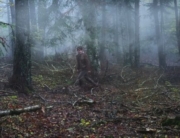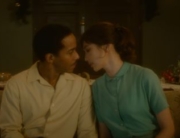
A woman is dragged across a swamp by an invisible force. Something monstrous has happened to her, or is about to.
The first minutes of Fever Dream introduce a delirious vision (Post-mortem? From the future?) guided by two narrators building and correcting the story they are telling together. The voice-overs are between a mother and a son, though they are not related to each other. Are they both ghosts? Or the soul of someone helping another? Feeling confused almost until the end is part of the tricky and immersive experience of this particular film. Whether you end up satisfied or disappointed depends on if you follow the advise of one of the narrators: pay attention to details.
This supernatural drama, directed by acclaimed Peruvian filmmaker Claudia Llosa (better known for her breakthrough 2009 film, The Milk of Sorrow), has been adapted from a novel. (All of Llosa’s previous films have been solely written by her.) The source material is Distancia de Rescate (The Rescue Distance, the original name of the film in Spanish too) by Argentinian writer Samanta Schweblin, co-screenwriter alongside Llosa.
The woman who narrates, Amanda (María Valverde), arrives at a country house for a summer vacation accompanied by her little daughter, Nina (Guillermina Sorribes). Her husband is to join them in a few days. The boy who responds to Amanda in the voice-over is David (Emilio Vodanovich), son of the neighbor Carola (Dolores Fonzi). Both women establish an instant bond once they meet, as two mothers in need of a friend. Carola is the outspoken and energetic local beauty of a rural community, and she’s spellbinding to a city woman like Amanda.
However, Carola’s extroversion hides a few secrets that she reveals to her new friend readily. She claims her son is not really her son, that he changed after a near-death illness. Years ago, he became seriously ill, and the mother’s last resource was to visit the healer in the so-called “green house.” To save his life caused Carola to make a sacrifice that still reverberates.
Trying to make a chronological description of the events portrayed would go against the nature of the movie, which constantly fights against a linear progression. In many scenes, the two voices intervene to reach agreements about how to tell the story correctly so Amanda can understand what has happened to her. David warns her that they would have to start the story again if she doesn’t focus on the details.
What happens to Amanda and by extension David is a starting point that makes room for other pressing questions: What price Carola did accept to save her son; why he is now dangerous and unrecognizable, according to his mother; and what will the future hold for Nina after Amanda increases the “rescue distance” between them—Amanda mentally measures the physical distance from her daughter, in case she ever needs to come to Nina’s aid. She fears that one day the distance will too large to save her.
Even beyond the paranormal events that later became prominent, Llosa and Schweblin never lose their focus, centered on the maternal concerns of these two women. It’s unfair to disclose too much about the twists, but enough to say that the story’s supernatural aspect involves the concept of soul’s migration, in which the salvation of someone through this process requires that the soul be fragmented. One half is released while the remaining half shares the body with another soul. A person cured after this method will never be the same.
The cinematography by Oscar Faura (The Orphanage) and the music by Nathalie Holt are compelling elements that enrich Fever Dream, a film marked by enigmatic atmospheres and frightening moments that complement an unpredictable story with a complex structure. It includes, for example, one of the most strikingly composed shots I have seen in any movie this year: the silhouette of a man taking care of a horse. The two figures merge as if to become a centaur.
It’s a hard to classify this movie. More than a genre exercise in horror or fantasy, it’s an exploration on the identity of being a mother, told from a fresh point of view.
















Leave A Comment